 Leading Blog | Posts by Month |
 Leading Blog | Posts by Month |
02.28.10

LeadershipNow 140: February 2010 Compilation
Posted by Michael McKinney at 08:06 AM
02.26.10

Are Leaders Destined to Disappoint?Historian David Greenberg wrote in the Atlantic, “Americans have fallen, starry-eyed, for leaders who speak of a future unencumbered by history’s weight.” Intellectually we must know that this isn’t possible, yet is it too much to expect real change, fundamental change—a break from the past? It’s unsettling to think that we are only slaves to our past. Are we demanding too much?Greenberg continues, “Theodore Roosevelt’s New Nationalism, Woodrow Wilson’s New Freedom, FDR’s New Deal, JFK’s New Frontier, even George H. W. Bush’s New World Order—all began with the promise of the new. Of course, after the flush of a campaign, both voters and presidents have invariably discovered that history imposes constraints.” And we are left disappointed. Of course, this dynamic affects not only political leaders, but leaders everywhere. One always has to deal with what is (past and present) and the real level of desire (the crisis)—for transformational change to occur. Leadership is a creative act. A leader seeking transformational change needs to have three basic elements in place: clearly defined goals (the how), strong values with which to measure those goals (the why), and an environment that is urgent to change (an opportunity). Expectations create opportunities for leaders. The motivation from which springs the leader’s initiative is most often influenced by certain expectations on the part of the potential followers. Rosalynn Carter once said, “A leader takes people where they want to go. A great leader takes people where they don't necessarily want to go, but ought to be.” This suggests that a leader’s responsibility is to do more than just serve up our wants. As Insead’s dean J. Frank Brown said, “Leaders must learn to listen and question before they act.” We get the wrong kind of leaders when we place all of the responsibility of our expectations on their shoulders. In that environment we will always find individuals that are all too happy to pander to us and promise what they can never deliver in return for a title—placeholder leaders. Leadership is a shared responsibility. A great leader must elevate their followers and give them power and responsibility to act or they can never really lead them. Greenberg writes, “Twenty-five years ago, the political scientist Theodore Lowi published a book called The Personal President He concludes, “It is easy to propose that we lower our expectations for our new presidents—even, or perhaps especially, for presidents who come bearing lofty promises of transformation. But we can’t correct the problem, Lowi’s diagnosis suggested, simply by resolving to demand less from our chief executives or by vowing to learn from the past. The problem is rooted in nothing less than the presidency’s assumption of immense powers, and of a central role in our imagination. Candidates have no better path to victory than by inspiring us with dreams of a new political era, and presidents have no choice but to attempt “too much.” In doing so, however, they can only disappoint us.” Perhaps we aren’t demanding too much of our leaders, we are instead, demanding too little of ourselves. Can we separate ourselves from our “history” and act creatively for real change? Maybe we need a little less heroic leader and a little more heroic follower? It requires leadership at all levels.
Posted by Michael McKinney at 04:16 PM
02.23.10

The Purpose of Business is to Win Respect
Posted by Michael McKinney at 03:02 PM

5 Global Trends Unfolding Over the Next DecadeIn an address by Muhtar Kent, President and CEO, The Coca-Cola Co., he described five global forces that will unfold over the next decade. Although he is focusing on the beverage industry, these are trends that will impact many industries.
Posted by Michael McKinney at 09:38 AM
02.21.10

What Organizations Value in Leaders Bloomberg BusinessWeek.com and Hay Group have released the results of their annual survey which ranks the best companies for leadership and examines how those companies develop leaders. Last year the quality that the Top 20 companies valued most in their leaders was execution—the ability of leaders to achieve results through others. This year, the most valued quality is strategic thinking. "This year's emphasis on strategic thinking suggests that, like an individual recovering from a personal upheaval, businesses today are taking stock: reviewing their options, rethinking their strategies, considering new opportunities and innovations." It also suggests more long-term thinking. 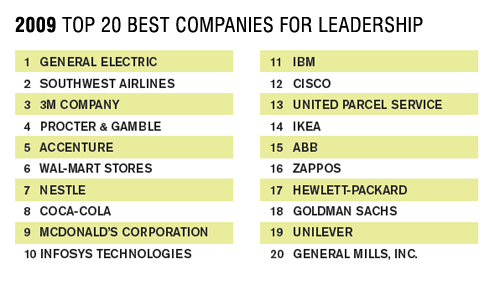
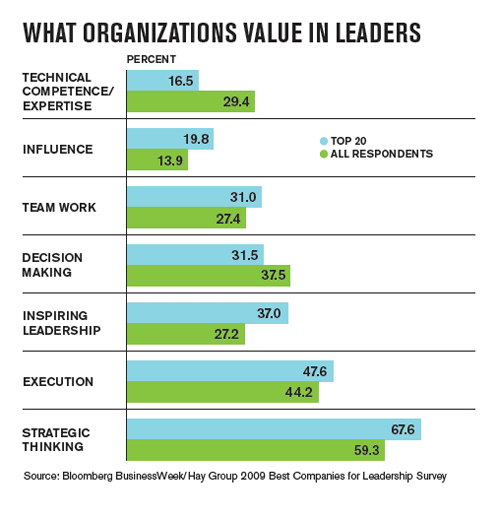 "While the data suggest there is no one best way to grow leaders, the companies that do it best share certain key characteristics. The top 20 companies address leadership development on multiple fronts, from articulating how leadership behavior needs to change to meet the challenges of the future to managing their pools of successors for mission-critical roles. And, despite the chaotic, crisis-strewn atmosphere of the past year, they've continued to make leadership a top priority."
Posted by Michael McKinney at 09:39 AM
02.18.10

How Fascinating is Your Message?
ROBERT LOUIS STEVENSON said, “Everyone lives by selling something.” Leaders are always selling something—an idea, change, themselves or even their example. It’s influence. While we know a clear consistent message is necessary it is often hampered or even marginalized by competing messages and issues. Sally Hogshead is an expert at delivering messages and changing people’s minds. In her book Fascinate: Your 7 Triggers to Persuasion and Captivation, she writes, “A competitive environment demands a more captivating message.” A more captivating message is a more fascinating one. Fascination is the connection we make with others that causes them to change their mind and behave differently. “People won’t change a preference, start a thought process, form a bond, or make a behavioral shift unless they’re provoked to change their opinions or actions.” Fascination provides the provocation. A fascinating message steps outside the norms in one or more of the following ways: provokes strong and immediate emotional reactions (love it or hate it), creates advocates, becomes “cultural shorthand” for a specific set of actions or values (people identify with it), incites conversation, forces competitors to realign around it, and/or triggers social revolutions (forces us to think differently). The key to mastering fascination is learning to effectively activate the seven triggers:
The point of all this is that you can make your message (or yourself for that matter) more fascinating. “All seven triggers affect decision making whether or not we intend them to.” She offers tools for evaluating your message, developing the appropriate triggers and then executing those triggers. She says there’s no “right” way to fascinate and that’s a good thing because we all operate a bit differently and tend to utilize different combinations of the fascination triggers. On her web site you can find out your fascination score (F Score) by taking a short test. In an interesting example concerning teenage drinking and driving she notes that a graphic photo of a car wreck doesn’t seem to effectively dissuade teenage drivers. For teens, fear isn’t necessarily a reason to avoid something. How do you provide a fascinating message for this group? Luke Sullivan, a legendary advertising writer, solved the problem. Luke knew that teems don’t fear death in the same way as adults. He also figured out what does create alarm among these drivers: Losing their license. Armed with that fact, he threatened teens with the ultimate dire consequence. How could you change your message to make it more fascinating and thus more effective for your audience? Throughout the book she blends art and science to demonstrate what fascinates people and why. You might be surprised to find out which fascinations are driving your own behavior. Her writing style and examples are very entertaining. “Whether we realize it or not—whether you intend to or not—you’re already using the seven triggers,” she writes. “The question is, are you using the right triggers, in the right way, to get your desired result? By mastering the triggers, your ideas become more memorable, your conversations more persuasive, and your relationships more lasting.” How do you try to change people’s minds? Could you make your message more fascinating? 
Posted by Michael McKinney at 05:47 PM
02.16.10

Leading Views: Law of Unintended Consequences In Thriving In the New Economy by Lori Ann LaRocco, Larry Lindsey, CEO of economic advisory firm The Lindsey Group, says that to thrive in time of crisis you need objectivity. It means that you don’t get caught up in the moment. This requires the perspective that history can give you. He writes:
In Thriving In the New Economy by Lori Ann LaRocco, Larry Lindsey, CEO of economic advisory firm The Lindsey Group, says that to thrive in time of crisis you need objectivity. It means that you don’t get caught up in the moment. This requires the perspective that history can give you. He writes:
One of history’s great lessons is that policy makers, in both the public and private sectors, tend to underestimate the costs involved when they contemplate the actions necessary to address some adverse change in circumstances. Although this is due in part to long periods of conditioning to the relationships and magnitudes that existed before the crisis, an equally important cause of the underestimation is the Law of Unintended Consequences. Even the most carefully designed policy responses involve unforeseen results, and in a crisis, there is not the time for as careful a consideration of the consequences of policy as might be ideal. The way we approach this challenge is to imagine ourselves as future historians writing about the events of the present. This causes us to contemplate an outcome, which we as future historians have the advantage of knowing with 20/20 hindsight, and then work back to establish a chain of events that led to that outcome. When you do that, you have to visualize how something is going to happen and decide whether or not your vision is realistic. If it is not realistic, you reject it. Thus, only a small fraction of the speculative ‘‘future histories’’ one considers actually make it into the range of plausible scenarios. This future-history approach doesn’t guarantee that you will have picked the right future, but it does facilitate objectivity. Once present-day events occurred that differed from what you imagined, that is, once the world ended up somewhere other than where you thought it was going to end up, you would know that, objectively, you were wrong. Of Related Interest:
Posted by Michael McKinney at 04:11 PM
02.15.10

George Washington: It’s Never too Early to Choose to LeadGreat leadership doesn’t just happen. Great leaders are revealed in extraordinary circumstances, but they are made long before. A person’s quality of leadership radiates from their character. Consequently, it’s never too early to begin your leadership development. By age sixteen, Washington had copied out by hand, 110 Rules of Civility & Decent Behavior in Company and Conversation. They are based on a set of rules composed by French Jesuits in 1595. The first rule sets the tone of the others that follow: “Every Action done in Company, ought to be with Some Sign of Respect, to those that are Present.” There isn’t a leader that wouldn’t benefit from a daily reminder of this approach. Time and time again, these rules from his childhood played out in the conduct of his public life and defined his reputation. These rules and his concern for them integrated him as a leader and bonded him with those he led. George Washington’s father died when he was eleven leaving him to be raised by his older brother Lawrence. By age fifteen his formal schooling was over and he had achieved the equivalent of only a grade school education. But his education never stopped. Washington was an avid reader, soaking up the works of historians and thinkers. He was especially drawn to the essays of the Roman philosopher Seneca and Joseph Addison’s play Cato with its lesson in selfless leadership. He studied the ideas of his contemporaries in writings and conversation. He also spent a good deal of time writing which helped to solidify his thoughts. Learning is more than discovery. It helps us to make sense of things. It’s more than collecting information—it is applying it in a constructive way to some area of our life. It is the mindset of a leader to work on themselves harder than they work on others. A leader’s first responsibility is governing themselves. Historian Gordon Wood has written, “Washington became a great man and was acclaimed as a classical hero because of the way he conducted himself during times of temptation. It was his moral character that set him off from other men.” Leadership is embodied in the way you look at the world and respond to it. It’s never too early to choose to lead.
Posted by Michael McKinney at 02:45 PM
02.12.10

Getting Naked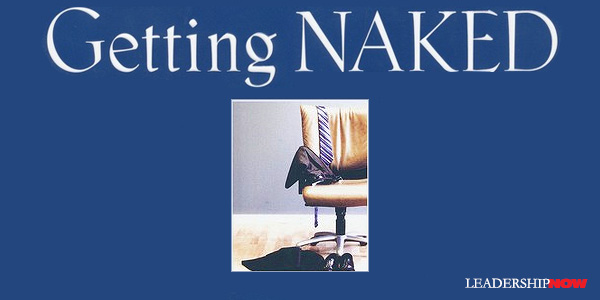
PATRICK LENCIONI has penned another solid business fable, Getting Naked and it's about vulnerability. The kind of vulnerability that comes from being completely open and honest with no sense of pretense or cover. He calls it getting naked. The story grows out of his experience in his consulting practice, The Table Group. They found that by being completely transparent and vulnerable with clients, they built levels of trust and loyalty that blew them away. Getting naked is not easy to do. It goes against the grain. It’s not comfortable. It involves shedding the three fears that sabotage client loyalty: Fear of Losing the Business - No service provider wants to lose clients or revenue. Interestingly, it is his very notion that prevents many service providers from having the difficult conversations that actually build greater loyalty and trust. Clients want to know that their service providers are more interested in helping them succeed in business than protecting their revenue source. To Overcome: Give Away the Business, Consult Instead of Sell, Tell the Kind Truth, Enter the Danger Fear of Being Embarrassed - This fear is rooted in pride. No one likes to publicly make mistakes, endure scrutiny or be embarrassed. Naked service providers are willing to ask questions and make suggestions even if those questions and suggestions turn out to be laughably wrong. Clients trust naked service providers because they know that they will not hold back their ideas, hide their mistakes, or edit themselves to save face. To Overcome: Ask Dumb Questions, Make Dumb Suggestions, Celebrate your Mistakes Fear of Being Inferior - Similar to the previous fear, this one is rooted in ego. Fear of being inferior is not about being intellectually wrong, it is about preserving social standing with the client. Naked service providers are able to overcome the need to feel important in the eyes of their client and basically do whatever a client needs to help the client improve. To Overcome: Honor the Client’s Work, Make Everything about the Client, Do the Dirty Work, Take a Bullet 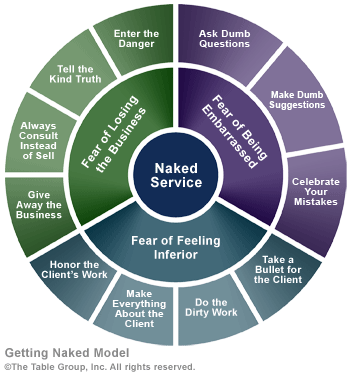 Why don't all service providers do this? Lencioni says, “On the surface the approach may sound soft or commonplace, but actually putting it into action can be downright scary. Getting naked is not for the faint-of-heart and those who employ this approach need to be prepared for the potential costs. Naked service providers leave themselves exposed to criticism and rejection, and may lose some business. However, once they prepare themselves for those situations, they find that they actually receive less criticism and are much better able to attract and retain clients. What is more, when they do lose a potential client due to their naked approach, they have no regrets because they realize that the relationship wouldn't have been a productive one anyway. “Not everyone is fit to be a naked service provider. It requires levels of self-esteem, humility, and courage that not all consultants are interested in having. However, anyone who is willing to set their ego and fear aside can practice the approach successfully. And they will benefit both in terms of the success of their business as well as experiencing growth in their personal lives.” Although this book is aimed at service providers it has wider applications and provides a general lesson for all leaders in any situation: We go a lot further if we demonstrate that we are more concerned about helping the people we lead, than we are in protecting ourselves. Stop trying so hard to be impressive. Just see where you can help. Great service makes a great impression. Getting Naked Resources on the Table Group website. 
Posted by Michael McKinney at 03:02 PM
02.10.10

Leaders Make Connections
THE Financial Times ran an excellent analysis on February 3rd by Edward Luce concerning the very tight inner circle—just four people—that Mr. Obama relies on for advice. In America: A Fearsome Foursome, Luce advocates a broader circle of advisers and notes, “To be successful, presidents need to separate the stream of advice they get on policy from the stream of advice they get on politics.” Intellectually we know that we need to get their advice and information from a wide variety of sources. In practice, however, it doesn’t always happen. We like to talk to those with whom we are comfortable with and share our views. It’s very reassuring. But dangerous. Dangerous because it clouds our vision and makes us less agile. More importantly, seeking the opinions of others helps to make them feel a part of a larger purpose, connected to the leader and a part of a community. This points to a basic function of leadership: to make connections. 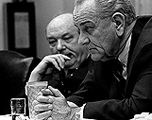 Treasury Secretary Henry Fowler, shrewd, effective, a superb negotiator, but somewhat shy of Lyndon Johnson, would occasionally feel in need of a presidential laying on of hands even when he had no serious presidential business. After one such occasion—it had ended with Fowler, sitting on the edge of the Oval Office loveseat, reading in monotone from his own memo on the floor in front of him, while the president was plucking yellow news tickers from the ticker machine at the opposite end of the Oval—LBJ turned on me, angrily: “What on earth did you bring him in here for, wasting my time ...” and so forth, but then stopped himself mid-sentence. “No, I’m wrong. Make me see him when he asks even if he has no real business! While you staff fellows are safe in the White House, these cabinet fellows are out there every day being shot at, on the Hill, in the papers, on TV. They are my field generals. Never forget that. They’ll be useless to me if they don’t feel connected to me. Always treat them with dignity.” A leader’s position is in the middle; to share and connect. In a world bent on differentiation, leaders must make connections.
Posted by Michael McKinney at 12:00 AM
02.08.10

12 Behaviors You Can Practice to Make You a More Inspiring Leader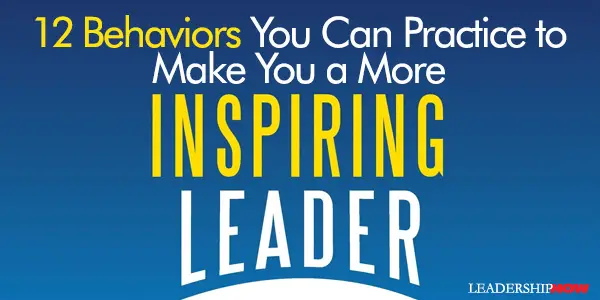
JACK ZENGER, Joe Folkman and Scott Edinger conducted a four year study of over 200,000 responses describing 20,000 leaders to determine what makes an outstanding leader. The results pointed to the fact that the ability to “inspire and motivate to high performance” was the single most powerful predictor of being perceived as an extraordinary leader. It was the best predictor of overall ratings of leadership effectiveness by direct reports, peers, and managers, it was the quality most valued by employees, and it was the factor most correlated with employee commitment and satisfaction. And it was found to be cross-generational. Inspiration, they point out in The Inspiring Leader, is not sufficient in and of itself. “Its power comes when it is placed in combination with other leadership attributes.” It works as a catalyst. Throughout the book, they discuss a large number of steps you should consider to become a more inspiring leader, but here is a selection of twelve behaviors that you can apply now:

Posted by Michael McKinney at 12:12 AM
02.05.10

Drive: What’s Motivating You?
WHEN it comes to motivation, I think we can all agree on one thing: People are motivated in different ways—often surprisingly different ways—at different times depending on their needs, wants, desires, philosophy, age, friends, status, values, circumstances, background, mood, attitude, insecurities, self-absorption, and a number of things I left out for the sake of brevity. Obviously, when it comes to motivation, one size doesn’t fit all, best practices don’t work across the board, and our approaches to motivation must begin with respect. In Drive, Dan Pink defines three types of motivational operating systems or assumptions about how humans behave from which a motivational construct can be created: Motivation 1.0 presumes that humans are biological creatures, struggling for survival.Motivation 2.0 presumes that humans also respond to rewards and punishments in their environment. It seeks compliance. Motivation 3.0 presumes that humans also have a third drive—to learn, to create, and to better the world. It seeks engagement. Listed the way they are, it is tempting to think of this as a historical progression moving from the base world of the caveman to the enlightened world of today. In fact, these types of motivation have been with us throughout history, however today we are blessed with the opportunity to contemplate Motivation 3.0 on a scale that was never before possible. And we should. The most important point Pink makes is that we still use Motivation 2.0 as a fallback motivational construct for almost any situation we encounter—and most often to our detriment. Stating the problem, he writes: Too many organizations—not just companies, but governments and nonprofits as well—still operate from assumptions about human potential and individual performance that are outdated, unexamined, and rooted more in folklore than in science. They continue to pursue practices such as short-term incentive plans and pay-for-performance schemes in the face of mounting evidence that such measures usually don’t work and often do harm. Worse, these practices have infiltrated our schools, where we ply our future workforce with iPods, cash, and pizza coupons to ‘incentivize’ them to learn. Something has gone wrong. Something has gone wrong—or—maybe has never really been sufficiently addressed. Carrot-and-stick motivators are much easier to implement than intrinsic motivators. Who has the time? But as work changes—“more complex, more interesting, and more self-directed”—intrinsic motivation is going to be a much larger, pressing concern to leaders. But, I think it would be wrong to assume that Motivation 1.0 and 2.0 are no longer of any consequence. We must recognize that people are at different places at different times in their lives. A person could even prefer Motivation 2.0 for their own 3.0 reasons. Extrinsic motivators have their place in many situations, especially when time is an issue. Although extrinsic motivators may be hit-or-miss, they often get the job done and they are fairly easy to implement in an even-handed way. The problem is that they are overused and often used exclusively. Extrinsic motivators are grounded in short-term thinking and will not provide lasting results. Unfortunately, we do create systems and workplaces that encourage behavior driven by extrinsic motivation that doesn’t satisfy our need for meaning. Extrinsic motivators will never give employees the autonomy, mastery and purpose that Pink calls for. Nor are they really designed to do that. They simply influence short-term behavior to a desired end. There are times when Pink’s research leads to overreaching conclusions, but his basic argument that we are designed to be “autonomous, self-determined, and connected to one another” and that “when that drive is liberated, people achieve more and richer lives” is a sound one. As he suggests, we should try to move people and work to a Motivation 3.0 construct that fosters what he terms Type I behavior. Type I behavior is “a way of thinking and an approach to life built around intrinsic, rather than extrinsic, motivators. It is powered by our innate need to direct our own lives, to learn and create new things, and to do better by ourselves and our world.” The last third of the book is a toolkit for fostering more Type I behavior. There are practical suggestions for the workplace, but some of his best suggestions are for parents and educators. If some of these ideas were put into practice, we would probably turn out more engaged kids, with critical thinking skills and a life-long love for learning. In all, Pink makes a good case for the adoption of Motivation 3.0 based on the widely accepted fact that work that makes us feel in control of our lives is better than work that doesn’t. Some work has the potential to do that and some work never really will. But, if Drive raises our awareness and causes us to re-examine how we are motivating people (or not) and the effects of the systems we create, then it will have made a serious contribution to making our organizations a better place to work and helping people to fulfill their potential. 
Posted by Michael McKinney at 07:38 AM
02.03.10

The Right Fight
IF YOU believe that the single most important thing leaders have to get right is alignment, if you think that the leader’s time is best spent promoting teamwork and making sure everyone is on the same page and playing nice, then you might want to take a look at Saj-Nicole Joni and Damon Beyer’s book, The Right Fight. The book is based on a counterintuitive premise: In an environment where alignment is the only goal, alignment robs us of necessary dissent, of the checks and balances that mitigate risk, and of the tensions that create innovation and sustainable value. In short, you need to systematically orchestrate the right fights but … you need to fight them right. The Right Fight principle is based on the idea that you learn and grow by the right amount of friction and stress. “A certain amount of healthy struggle is good for organizations and for individuals. Indeed, people and organizations perform optimally when they are under the right kinds and amounts of stress.” They add, “With alignment and properly managed tension, organizations hit a sweet spot and start realizing their potential.” Citing a study by Theresa Wellbourne of eePulse, the single greatest predictor of poor performance is when employees are happy or complacent and thus unmotivated to change. The second greatest predictor is when employees are overwhelmed. Both groups exhibit a low level of energy. They conclude that “Tension in the right measure creates the emotional energy people need to change.” The trick for leaders is to avoid these extremes. “Knowing where and when to use tension is critical. Knowing how to work through the tension is equally important.” They lay out three principles that identify right fights and three more principles that clarify the rules of engagement. The first three Right Fight Principles will help you in identifying and eliminating destructive tensions: Right Fight Principle #1: Make it Worth Fighting About. Make it Material. “A right fight has to create significant value, require integration of multiple perspectives, and change the way work gets done in an organization. In short, a material fight is worth the trouble.” Right Fight Principle #2: Focus in the Future, Not the Past. “Obsession with past performance, or intense interest in decisions made months or even years before, is a dead giveaway that your organization is stuck in a wrong fight.” Right Fight Principle #3: Pursue a Noble Purpose. “Right fights connect people with a sense of purpose that goes beyond their own self-interest, unleashing profound collective abilities to create in ways they didn’t think possible.” The final Right Fight Principles guide you in fighting right fights right: Right Fight Principle #4: Make it Sport, Not War. “Right fights, like sports, have to have rules. One of the key tasks for leadership in a right fight is to define the parameters so everyone involved understands how to participate and what it takes to win.” Right Fight Principle #5: Structure Formally but Work Informally. “You need to structure right fights through the ‘formal organization,’ but work out the tensions created by those fights through the ‘informal organization.’” Right Fight Principle #6: Turn Pain into Gain. “There is a fine line between productive tension and destructive distress, and no two people draw that line in exactly the same place. For right fights to be fought right, leaders need to make sure no one is put under unbearable pressure. Turning pain into gain requires leaders to relate to their team members as individuals and to figure out what creates synergy, stretches skills, and honors outcomes for each of them.” There are case studies to illustrate each of these principles in action. It’s easy to see the negative side of tension: focusing on the past, stigmatizing the losers, fighting over turf. “But without tension, nothing moves.” Tension creates an opportunity for leaders to help their organizations fight the right fight. 
Posted by Michael McKinney at 08:57 AM
02.02.10

Leading Views: Toxic Emotions in the Workplace Peter Frost explains in Toxic Emotions at Work Peter Frost explains in Toxic Emotions at WorkIt is true that good leadership by its very nature engenders pain. It pushes people out of their comfort zones—which is necessary to get things done in a world of competition and change. Even so, some managers are malicious or lack good decision-making or people-managing skills, and therefore unduly contribute to the frustration, anger and low morale of their employees. Not just managers but organizations themselves create conditions for toxicity through policies and practices that fail to include the human factor in their execution. Their modes of production, especially the ever-changing technologies of work, squeeze out time for humanity, for civility, for people to reflect on their actions. We need to recognize that the values we reinforce in our organizations often are a prime source of toxicity. Unbridled attention to the bottom line, regardless of what it takes to achieve a given return on investments, blinds us to the possibilities of even more long-run effectiveness, if we take into account the value and emotional health of our workforce. The toxicity that flows from managers who ignore the emotional costs of their actions (to themselves and to others) can poison the wells of innovation and goodwill in the company. Corporate lies, distortions, and manipulations that cover up mistakes and foster self-aggrandizement do little to benefit any of the stakeholders.
Posted by Michael McKinney at 09:00 AM
02.01.10

First Look: Leadership Books for February 2010Here's a look at some of the best leadership books to be released in February.




For bulk orders call 1-800-423-8273
Posted by Michael McKinney at 08:52 AM
|
BUILD YOUR KNOWLEDGE


How to Do Your Start-Up Right STRAIGHT TALK FOR START-UPS 
Grow Your Leadership Skills NEW AND UPCOMING LEADERSHIP BOOKS 
Leadership Minute BITE-SIZE CONCEPTS YOU CAN CHEW ON 
Classic Leadership Books BOOKS TO READ BEFORE YOU LEAD |
|